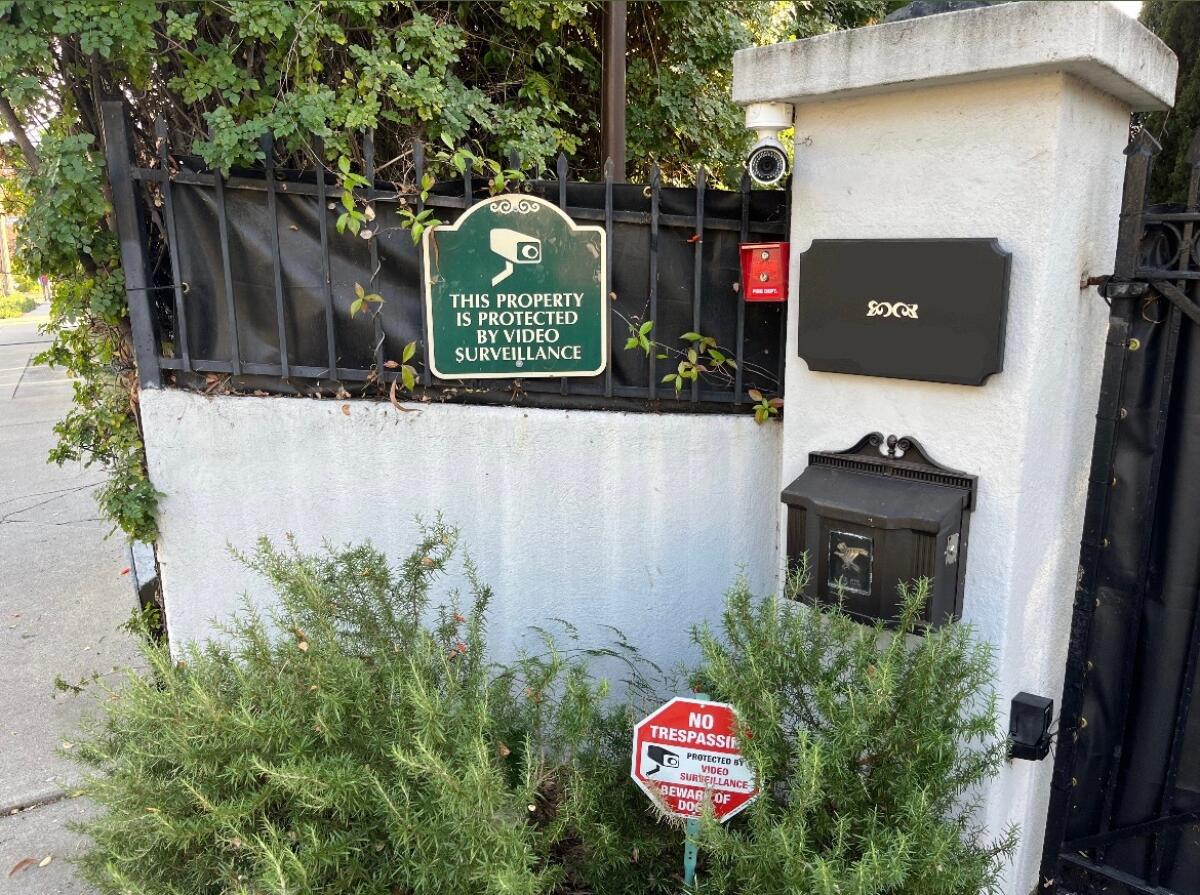Business
Black-trimmed homes, tiny libraries and other signs your neighborhood is about to be gentrified

A shift in demographics. Affordable apartments transformed into luxury condos. A coffee shop called something like “Brew Slut.”
The signs of gentrification take many forms. A newly opened art gallery can serve both as a communal space and a harbinger of the displacement to come. Remodeled homes might boost a street’s curb appeal but then drive up rents in the ensuing months and years.
There are plenty of ways to tell when gentrification is coming to a community; rising home prices and an influx of trendy shops are classic omens. But in the modern market, developers are flipping houses at the highest rate since 2000, and the houses they churn out are often homogeneous: boxy, black and white, minimalist. They’re adorned with trendy house number fonts and chic drought-tolerant gardens, and they can be an obvious sign of gentrification on the way.
Take a stroll through your neighborhood and keep an eye out for these trends. If you spot a few, gentrification may be on the way. If you spot a bunch, it might be well underway.
The gentrification font
If Neutraface starts speckling the homes and fences around your neighborhood, your rent might soar soon.
The sleek typeface and its many knock-offs have become so commonplace that they’ve become a meme, and the Guardian even declared it “the gentrification font.” It crowns countless brand-new builds across L.A., and like certain wines and cheeses, it pairs well with cheaply done fixer-uppers or the aforementioned box houses.
House numbers are presented in a chic font.
(Jack Flemming / Los Angeles Times)
“The Shake Shack font has invaded,” said Steven Sanders, a Highland Park resident who has lived in the rapidly changing neighborhood since 2015. When Sanders moved there, the median single-family home value was around $463,000, according to Zillow. Today, it’s $1.002 million.
There’s nothing specifically wrong with the font; it’s clean, modern and easy to read. Ironically, it’s named after Richard Neutra, an iconic architect who often stressed affordability in his work.
If a for-sale house has a Neutraface house number, the listing price will probably be anything but affordable.
Gentrification bonus point: if the font is also brass or gold.
Black-and-white paint jobs

This two-story home features a black-and-white exterior.
(Jack Flemming / Los Angeles Times)
Gentrification, in terms of housing, has become a monochromatic movement. Gone are the green-colored Craftsmans or the pink-hued bungalows of old; today, newly built homes are overwhelmingly white, black or a brutal combination of the two.
“Taste aside, a black house in an era of climate change is ridiculous,” said Adam Greenfield, a transportation and land-use advocate.
Gentrification bonus point: if a black-and-white exterior comes with an accent door — a splash of bright blue, yellow or turquoise to showcase that the property isn’t completely devoid of character. Just mostly devoid of character.
Excess security cameras

Multiple cameras are posted outside an Eagle Rock home.
(Jack Flemming / Los Angeles Times)
If you’re taking a stroll down your street and feel watched — not by anyone specific, but by a small army of Ring doorbells, Nest cameras and other electronic eyes making sure you don’t pick a Meyer lemon or that your dog doesn’t defecate on the decomposed granite — brace for a new brand of neighbor.
Surveillance systems and the context behind them, in which owners view their neighbors and passersby as potential package-stealers, are all too common in gentrifying communities. For if it were truly a high-crime place, there would still be chain link and barred windows.
There’s plenty of evidence that smart doorbells lead to racial profiling, and while there’s nothing inherently wrong with security systems, they generally detract from the community feel instead of adding to it.
“It’s the degradation of the social fabric that for so long we all took for granted,” Greenfield said. “It’s legitimate to walk up to a neighbor’s door to ask for or offer something, and security cameras and warning systems discourage that. We can’t let fear win in our society.”
Gentrification bonus point: if they come with a speaker with a disembodied voice that barks at passersby in a condescending tone: “Hi! You are currently being recorded.”
Privacy fences
Sometimes, surveillance systems aren’t enough. Many modern homeowners moving into new neighborhoods don’t even want to be seen by neighbors, so they install privacy fences or towering hedges to shield themselves from anyone walking by.
Greenfield calls them “f— you fences.”
“Many people were raised in the suburban sprawl, where they don’t have as much access to other people. Then they move to denser areas and import those suburban norms of separation and privacy,” Greenfield said.
Lola Rodriguez, a Lincoln Heights resident who grew up in the area, said if a home in the neighborhood is ever hidden from view, it’s usually someone who just moved in.
Gentrification bonus point: if the privacy fence is chic and stylish, like the horizontal trend that has taken over in some areas.
Box houses

This modern five-bedroom home listed by Avo Atnalian in the hills of Highland Park is on the market for $2.498 million.
(Avo Atnalian)
One of the more uninspired architectural trends of the last century, modern box houses forgo attempts at character or ornamentation, instead serving as shrines to simplicity. They worship at the altar of minimalism, squeezing out as much square footage as zoning laws will allow.
They’re clean, they’re simple, and they’re a likely sign that a new demographic is moving into a neighborhood.
“It’s jarring seeing a bright white box house jammed between older houses with more character,” Rodriguez said. She prefers the neighborhood’s stock of century-old bungalows over the new homes being built.
The polarizing style isn’t for everyone, but it’s a hit for deep-pocketed buyers eyeing extra space. And box houses are quicker and cheaper to build for profit-minded developers, who will keep cranking out supply as long as there’s demand.
Gentrification bonus point: if the box house includes a glass garage door.

This modern home features a glass garage door.
(Jack Flemming / Los Angeles Times)
Drought-tolerant gardens
To be clear, the ecological benefits of drought-tolerant landscaping make it a net positive for Southern California. Limited water usage is absolutely a good thing.
But such gardens aren’t always cheap, and if they start popping up in neighborhoods where most residents can’t afford to spend thousands of dollars, sometimes tens of thousands, on their yard, it could be a sign of gentrification.
Most carry the same look: a handful of shrubs, succulents and cacti surrounded by gravel or decomposed granite, giving it a sandy, desert-like quality.

Drought-tolerant plants outside an Eagle Rock home.
(Jack Flemming / Los Angeles Times)
Kerry Kimble and Steven Galido, two real estate agents with the Agency, said they’ve noticed an increase in drought-tolerant gardens in neighborhoods such as Echo Park, Highland Park and Silver Lake, where displacement has already been happening for years.
The majority of Kimble’s listings are in northeast L.A., and she said she’s noticed a surplus of succulents.
Galido said some developers add drought-tolerant gardens to attract potential buyers.
“Developers remodel homes for the taste of the gentrifier,” he said.
The pair are currently listing a 106-year-old duplex in Angelino Heights, a neighborhood protected by a Historic Preservation Overlay Zone, which preserves a community’s architectural feel by limiting new building designs and renovations. But not every neighborhood enjoys such protection.

Firestick plants fill the gardens of many homes in gentrified neighborhoods.
(Jack Flemming / Los Angeles Times)
Gentrification bonus point: if the garden is riddled with Firestick plants — the trendy, orange-tipped succulents that seem to anchor every lawn in those “up-and-coming” neighborhoods.
Little Free Libraries
Listen, these are lovely. Unlike surveillance systems and privacy fences, little libraries actually evoke a sense of community, bringing neighbors together over a shared love of literature (even though most generally seem to be stocked exclusively with James Patterson novels and unreadable how-to books).

A Little Free Library is posted outside a home.
(Jack Flemming / Los Angeles Times)
The charming, birdhouse-like structures certainly don’t cause gentrification, despite what a handful of critics have claimed over the years. But they definitely seem to be a product of gentrification, usually popping up in areas where home prices are rising and well-to-do residents are moving in.
Gentrification bonus point: if a smart doorbell camera watches over the library, making sure nobody takes more than their fair share of books.
Pointed listing language
Sometimes, the clearest sign of gentrification is hearing how people are talking about a neighborhood and the homes within it. There’s a wealth of such examples posted daily on Zillow, Redfin and other listing sites as real estate agents take on certain tones to market properties to potential buyers.
For example, if a listing brags about the home being some kind of port in a storm, a refuge from the area around it, a ship of gentrifiers might be sailing in. One listing in Boyle Heights is touted as an “urban oasis.” Another in South L.A. promises to add “a touch of serenity to urban living.”
Also pay attention to whether a listing is marketed as an actual place to live or simply an investment opportunity. This listing near Leimert Park asks potential buyers to “come see your future investment today.” An Elysian Heights listing touts its use as an Airbnb.
Gentrification bonus point: if the language sounds like an extra flowery wellness ad, such as this listing in East L.A.: “Imagine stepping into a world where every corner whispers tales of renewal.”

Business
After 57 years of open seating, is Southwest changing its brand?

Jim Kingsley of Orange County, who recently flew Southwest on a two-leg journey from Minneapolis to Los Angeles, likened the budget-friendly airline to In-N-Out Burger.
Both brands are affordable, consistent and more simplistic compared with competitors, Kingsley said.
“They’re not trying to offer all the things everybody else offers,” he said, “but they get the quality right and it’s a good value.”
Change, however, is in the air.
Southwest, which since its founding nearly 60 years ago has positioned itself in the cutthroat airline industry as an easygoing, egalitarian option, upended that guiding ethos this week with word that it would get rid of its famous first-come, first-seated policy in favor of traditional assigned seats and a premium class option. They will also offer overnight, red-eye flights in five markets including Los Angeles.
Experts say the changes, especially the switch to assigned seating, are a smart move and will appeal to many as the company tries to stabilize its precarious finances that included a 46% drop in profits in the second quarter from a year earlier to $367 million. But it remains to be seen whether Southwest will pay an intangible cost in making the moves: Will it be able to hold on to its quirky identity or will it put off loyal customers, and in doing so, become just another airline?
“You’re going to hear nostalgia about this, but I think it’s very logical and probably something the company should have done years ago,” said Duane Pfennigwerth, a global airlines analyst at Evercore.
“In many markets away from core Southwest markets, we think open seating is a boarding process that many people avoid,” he said.
That is all well and good, but “I didn’t ask for these changes,” Kingsley said. “Cost and quality is what I care about.”
Open seating has its pros and cons, Kingsley said, though he’s generally a fan. On his trip to Los Angeles, his group wasn’t able to get seats all together. But he likes that preferred seats are available on a first-come, first-served basis, instead of being offered for a high price.
Eighty percent of Southwest customers and 86% of potential customers prefer an assigned seat, the airline said in a statement.
“By moving to an assigned seating model, Southwest expects to broaden its appeal and attract more flying from its current and future customers,” the airline said.
An even bigger draw of Southwest, according to Kingsley, is its policy of including two free checked bags per ticket. This perk often makes Southwest a better bargain, especially for longer trips or bigger groups, he said.
The free bags are a big deal to customers, experts said, and contribute to the airline’s consumer-friendly brand. The airline hasn’t indicated they plan to change their bag policy.
“Southwest has always had a really good, positive vibe,” said Alan Fyall, chair of Tourism Marketing at the University of Central Florida’s College of Hospitality. “It’s free bags, good prices and point-to-point routes. That’s what they stand for and that’s what people love about them.”
Southwest’s change to assigned seating doesn’t mean they’re no longer a budget-friendly airline, Fyall said, but it does differentiate them from the lowest-cost, lowest-amenity options such as Frontier and Spirit.
The move will also require Southwest to update all or a portion of its fleet to include first-class seats. Currently, all seats on a Southwest flight are identical. Fyall said it’s worth the investment.
It’s an appropriate time for Southwest to make adjustments, said Chris Hydock, an assistant professor at Tulane University’s Freeman School of Business.
“They’ve not been profitable the last couple of quarters and they’ve had some activist investor pressure to increase their revenue,” he said.
Costs such as wages and maintenance have risen across the airline industry even as travel increased after the pandemic. Southwest saw a net loss of $231 million in the first quarter of 2024. Wall Street analysts estimate that assigned, premium seating could boost revenue by $2 billion per year.
“This is one of the options where they could potentially increase their revenue and do something that a lot of consumers have a strong preference for anyway,” Hydock said.
For Southwest’s changes to pay off, it has to stick to its roots when it comes to its culture and brand, experts and travelers agreed.
“I love Southwest being different,” Kingsley said. “If they’re trying to be like the other airlines, I think they’re shooting themselves in the foot.”
Business
Column: 99 years after the Scopes 'monkey trial,' religious fundamentalism still infects our schools

Almost a century has passed since a Tennessee schoolteacher was found guilty of teaching evolution to his students. We’ve come a long way since that happened on July 21, 1925. Haven’t we?
No, not really.
The Christian fundamentalism that begat the state law that John Scopes violated has not gone away. It regularly resurfaces in American politics, including today, when efforts to ban or dilute the teaching of evolution and other scientific concepts are part and parcel of a nationwide book-banning campaign, augmented by an effort to whitewash the teaching of American history.
I knew that education was in danger from the source that has always hampered it—religious fanaticism.
— Clarence Darrow, on why he took on the defense of John Scopes at the ‘monkey trial’
The trial in Dayton, Tenn., that supposedly placed evolution in the dock is seen as a touchstone of the recurrent battle between science and revelation. It is and it isn’t. But the battle is very real.
Let’s take a look.
The Scopes trial was one of the first, if not the very first, to be dubbed “the trial of the century.”
And why not? It pitted the fundamentalist William Jennings Bryan — three-time Democratic presidential candidate, former congressman and secretary of State, once labeled “the great commoner” for his faith in the judgment of ordinary people, but at 65 showing the effects of age — against Clarence Darrow, the most storied defense counsel of his time.
The case has retained its hold on the popular imagination chiefly thanks to “Inherit the Wind,” an inescapably dramatic reconstruction — actually a caricature — of the trial that premiered in 1955, when the play was written as a hooded critique of McCarthyism.
Most people probably know it from the 1960 film version, which starred Frederic March, Spencer Tracy and Gene Kelly as the characters meant to portray Bryan, Darrow and H.L. Mencken, the acerbic Baltimore newspaperman whose coverage of the trial is a genuine landmark of American journalism.
What all this means is that the actual case has become encrusted by myth over the ensuing decades.
One persistent myth is that the anti-evolution law and the trial arose from a focused groundswell of religious fanaticism in Tennessee. In fact, they could be said to have occurred — to repurpose a phrase usually employed to describe how Britain acquired her empire — in “a fit of absence of mind.”
The Legislature passed the measure idly as a meaningless gift to its drafter, John W. Butler, a lay preacher who hadn’t passed any other bill. (The bill “did not amount to a row of pins; let him have it,” a legislator commented, according to Ray Ginger’s definitive 1958 book about the case, “Six Days or Forever?”)
No one bothered to organize an opposition. There was no legislative debate. The lawmakers assumed that Gov. Austin Peay would simply veto the bill. The president of the University of Tennessee disdained it, but kept mum because he didn’t want the issue to complicate a plan for university funding then before the Legislature.
Peay signed the bill, asserting that it was an innocuous law that wouldn’t interfere with anything being taught in the state’s schools. The law “probably … will never be applied,” he said. Bryan, who approved of the law as a symbolic statement of religious principle, had advised legislators to leave out any penalty for violation, lest it be declared unconstitutional.
The lawmakers, however, made it a misdemeanor punishable by a fine for any teacher in the public schools “to teach any theory that denies the story of the Divine Creation of man as taught in the Bible, and to teach instead that man had descended from a lower order of animal.”
Scopes’ arrest and trial proceeded in similarly desultory manner. Scopes, a school football coach and science teacher filling in for an ailing biology teacher, assigned the students to read a textbook that included evolution. He wasn’t a local and didn’t intend to set down roots in Dayton, but his parents were socialists and agnostics, so when a local group sought to bring a test case, he agreed to be the defendant.
The play and movie of “Inherit the Wind” portray the townspeople as religious fanatics, except for a couple of courageous individuals. In fact, they were models of tolerance. Even Mencken, who came to Dayton expecting to find a squalid backwater, instead discovered “a country town full of charm and even beauty.”
Dayton’s civic boosters paid little attention to the profound issues ostensibly at play in the courthouse; they saw the trial as a sort of economic development project, a tool for attracting new residents and businesses to compete with the big city nearby, Chattanooga. They couldn’t have been happier when Bryan signed on as the chief prosecutor and a local group solicited Darrow for the defense.
“I knew that education was in danger from the source that has always hampered it — religious fanaticism,” Darrow wrote in his autobiography. “My only object was to focus the attention of the country on the programme of Mr. Bryan and the other fundamentalists in America.” He wasn’t blind to how the case was being presented in the press: “As a farce instead of a tragedy.” But he judged the press publicity to be priceless.
The press and and the local establishment had diametrically opposed visions of what the trial was about. The former saw it as a fight to protect from rubes the theory of evolution, specifically that humans descended from lower orders of primate, hence the enduring nickname of the “monkey trial.” For the judge and jury, it was about a defendant’s violation of a law written in plain English.
The trial’s elevated position in American culture derives from two sources: Mencken’s coverage for the Baltimore Sun, and “Inherit the Wind.” Notwithstanding his praise for Dayton’s “charm,” Mencken scorned its residents as “yokels,” “morons” and “ignoramuses,” trapped by their “simian imbecility” into swallowing Bryan’s “theologic bilge.”
The play and movie turned a couple of courtroom exchanges into moments of high drama, notably Darrow’s calling Bryan to the witness stand to testify to the truth of the Bible, and Bryan’s humiliation at his hands.
In truth, that exchange was a late-innings sideshow of no significance to the case. Scopes was plainly guilty of violating the law and his conviction preordained. But it was overturned on a technicality (the judge had fined him $100, more than was authorized by state law), leaving nothing for the pro-evolution camp to bring to an appellate court. The whole thing fizzled away.
The idea that despite Scopes’ conviction, the trial was a defeat for fundamentalism, lived on. Scopes was one of its adherents. “I believe that the Dayton trial marked the beginning of the decline of fundamentalism,” he said in a 1965 interview. “I feel that restrictive legislation on academic freedom is forever a thing of the past, … that the Dayton trial had some part in bringing to birth this new era.”
That was untrue then, or now. When the late biologist and science historian Stephen Jay Gould quoted that interview in a 1981 essay, fundamentalist politics were again on the rise. Gould observed that Jerry Falwell had taken up the mountebank’s mission of William Jennings Bryan.
It was harder then to exclude evolution from the class curriculum entirely, Gould wrote, but its enemies had turned to demanding “‘equal time’ for evolution and for old-time religion masquerading under the self-contradictory title of ‘scientific creationism.’”
For the evangelical right, Gould noted, “creationism is a mere stalking horse … in a political program that would ban abortion, erase the political and social gains of women … and reinstitute all the jingoism and distrust of learning that prepares a nation for demagoguery.”
And here we are again. Measures banning the teaching of evolution outright have not lately been passed or introduced at the state level. But those that advocate teaching the “strengths and weaknesses” of scientific hypotheses are common — language that seems innocuous, but that educators know opens the door to undermining pupils’ understanding of science.
In some red states, legislators have tried to bootstrap regulations aimed at narrowing scientific teaching onto laws suppressing discussions of race and gender in the classrooms and stripping books touching those topics from school libraries and public libraries.
The most ringing rejection of creationism as a public school topic was sounded in 2005 by a federal judge in Pennsylvania, who ruled that “intelligent design” — creationism by another name — “cannot uncouple itself from its creationist, and thus religious, antecedents” and therefore is unconstitutional as a topic in public schools. Yet only last year, a bill to allow “intelligent design” to be taught in the state’s public schools was overwhelmingly passed by the state Senate. (It died in a House committee.)
Oklahoma’s reactionary state superintendent of education, Ryan Walters, recently mandated that the Bible should be taught in all K-12 schools, and that a physical copy be present in every classroom, along with the Ten Commandments, the Declaration of Independence and the Constitution. “These documents are mandatory for the holistic education of students in Oklahoma,” he ordered.
It’s clear that these sorts of policies are broadly unpopular across much of the nation: In last year’s state and local elections, ibook-banners and other candidates preaching a distorted vision of “parents’ rights” to undermine educational standards were soundly defeated.
That doesn’t seem to matter to the culture warriors who have expanded their attacks on race and gender teaching to science itself. They’re playing a long game. They conceal their intentions with vague language in laws that force teachers to question whether something they say in class will bring prosecutors to the schoolhouse door.
Gould detected the subtext of these campaigns. So did Mencken, who had Bryan’s number. Crushed by his losses in three presidential campaigns in 1896, 1900 and 1908, Mencken wrote, Bryan had launched a new campaign of cheap religiosity.
“This old buzzard,” Mencken wrote, “having failed to raise the mob against its rulers, now prepares to raise it against its teachers.” Bryan understood instinctively that the way to turn American society from a democracy to a theocracy was to start by destroying its schools. His heirs, right up to the present day, know it too.
Business
NASA identifies Starliner problems but sets no date for astronauts' return to Earth

After weeks of testing, NASA and Boeing officials said Thursday they have identified problems with the Starliner’s propulsion system that have kept two astronauts at the International Space Station for seven weeks — but they didn’t set a date to return them to Earth.
Ground testing conducted on thrusters that maneuver Boeing’s capsule in space found that Teflon used to control the flow of rocket propellant eroded under high heat conditions, while different seals that control helium gas showed bulging, they said.
The testing was conducted after the thrusters malfunctioned when Starliner docked with the space station on June 6 and a helium leak that was detected before launch worsened on the trip to the station. The helium pressurizes the propulsion system.
However, officials said the problems should not prevent astronauts Suni Williams and Butch Wilmore from returning to Earth aboard the Starliner capsule, which lifted off on its maiden human test flight June 5 for what was supposed to be an eight-day mission.
“I am very confident we have a good vehicle to bring the crew back with,” Mark Nappi, program manager of Boeing’s Commercial Crew Program, said at a news conference.
NASA and Boeing officials have said previously that the Starliner could transport the astronauts to Earth if there were an emergency aboard the space station, but they opted to conduct the ground tests to ensure a safe, planned return.
Decisions on whether and when to use Starliner or another vehicle will be made by NASA leaders after they are presented next week with all the information collected from the testing, which will include a “hot fire” test of the engines of the Starliner docked at the space station, Nappi said.
Rigorous ground testing conducted at NASA’s White Sands Test Facility on a thruster identical to the ones on the Starliner found that, despite the issues with Teflon degradation, the thruster was able to perform the maneuvers that would be needed to return Starliner to Earth, said Steve Stich, program manager for NASA’s Commercial Crew Program.
Official also have said that the Starliner still has about 10 times more helium than is needed to bring the capsule back to Earth.
The problems that have cropped up have been an embarrassment for Boeing, which along with SpaceX was given a multibillion-dollar contract in 2014 to service the station with crew and cargo flights after the end of the space shuttle program. Since then, Elon Musk’s Hawthorne-based company has sent more than a half-dozen crews up, while Boeing is still in its testing phase — with the current flight delayed for weeks by the helium leak and other issues that arose even before the thrusters malfunctioned.
Should NASA make a decision not to bring the crew home on the Starliner — which could still return to Earth remotely — the astronauts could be retrieved by SpaceX’s Crew Dragon capsule, though SpaceX’s workhorse Falcon 9 rocket is currently grounded after a failure this month.
The Russian Soyuz spacecraft also services the station and carries American astronauts.
-

 World1 week ago
World1 week agoOne dead after car crashes into restaurant in Paris
-

 Midwest1 week ago
Midwest1 week agoMichigan rep posts video response to Stephen Colbert's joke about his RNC speech: 'Touché'
-

 News1 week ago
News1 week agoVideo: Young Republicans on Why Their Party Isn’t Reaching Gen Z (And What They Can Do About It)
-

 Movie Reviews1 week ago
Movie Reviews1 week agoMovie Review: A new generation drives into the storm in rousing ‘Twisters’
-

 News1 week ago
News1 week agoIn Milwaukee, Black Voters Struggle to Find a Home With Either Party
-

 Politics1 week ago
Politics1 week agoFox News Politics: The Call is Coming from Inside the House
-

 News1 week ago
News1 week agoVideo: J.D. Vance Accepts Vice-Presidential Nomination
-

 World1 week ago
World1 week agoTrump to take RNC stage for first speech since assassination attempt















